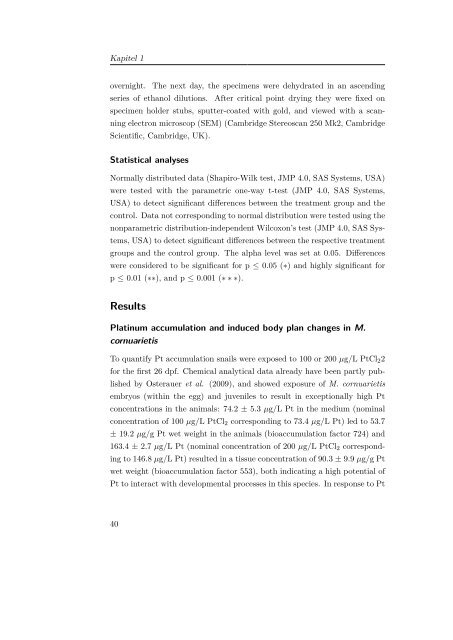Die Embryonalentwicklung der Paradiesschnecke ... - TOBIAS-lib
Die Embryonalentwicklung der Paradiesschnecke ... - TOBIAS-lib
Die Embryonalentwicklung der Paradiesschnecke ... - TOBIAS-lib
Create successful ePaper yourself
Turn your PDF publications into a flip-book with our unique Google optimized e-Paper software.
Kapitel 1<br />
overnight. The next day, the specimens were dehydrated in an ascending<br />
series of ethanol dilutions. After critical point drying they were fixed on<br />
specimen hol<strong>der</strong> stubs, sputter-coated with gold, and viewed with a scanning<br />
electron microscop (SEM) (Cambridge Stereoscan 250 Mk2, Cambridge<br />
Scientific, Cambridge, UK).<br />
Statistical analyses<br />
Normally distributed data (Shapiro-Wilk test, JMP 4.0, SAS Systems, USA)<br />
were tested with the parametric one-way t-test (JMP 4.0, SAS Systems,<br />
USA) to detect significant differences between the treatment group and the<br />
control. Data not corresponding to normal distribution were tested using the<br />
nonparametric distribution-independent Wilcoxon’s test (JMP 4.0, SAS Systems,<br />
USA) to detect significant differences between the respective treatment<br />
groups and the control group. The alpha level was set at 0.05. Differences<br />
were consi<strong>der</strong>ed to be significant for p ≤ 0.05 (∗) and highly significant for<br />
p ≤ 0.01 (∗∗), and p ≤ 0.001 (∗ ∗ ∗).<br />
Results<br />
Platinum accumulation and induced body plan changes in M.<br />
cornuarietis<br />
To quantify Pt accumulation snails were exposed to 100 or 200 µg/L PtCl 2 2<br />
for the first 26 dpf. Chemical analytical data already have been partly published<br />
by Osterauer et al. (2009), and showed exposure of M. cornuarietis<br />
embryos (within the egg) and juveniles to result in exceptionally high Pt<br />
concentrations in the animals: 74.2 ± 5.3 µg/L Pt in the medium (nominal<br />
concentration of 100 µg/L PtCl 2 corresponding to 73.4 µg/L Pt) led to 53.7<br />
± 19.2 µg/g Pt wet weight in the animals (bioaccumulation factor 724) and<br />
163.4 ± 2.7 µg/L Pt (nominal concentration of 200 µg/L PtCl 2 corresponding<br />
to 146.8 µg/L Pt) resulted in a tissue concentration of 90.3 ± 9.9 µg/g Pt<br />
wet weight (bioaccumulation factor 553), both indicating a high potential of<br />
Pt to interact with developmental processes in this species. In response to Pt<br />
40
















